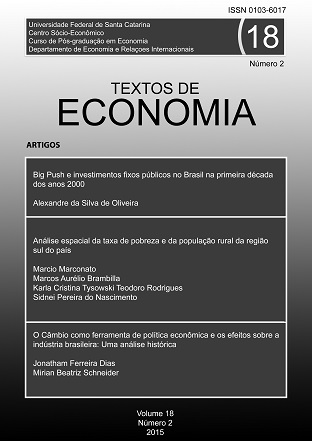Exchange as a tool for economic policy and effects on Brazilian industry: a historical analysis
DOI:
https://doi.org/10.5007/2175-8085.2015v18n2p41Abstract
Http://dx.doi.org/10.5007/2175-8085.2015v18n2p41
The objective of this study was to analyze the role of Brazilian exchange rate policy and its influence on the industrial sector. It can be verified that in Brazil a deindustrialization occurs as a loss of participation of the industrial sector in the Brazilian GDP. The abrupt commercial and financial liberalization in the 1990s, combined with an overvalued exchange rate policy in the 2000s, as a result of the Dutch Disease phenomenon in Brazil, may be negatively affecting the industrial sector. Even though the Lula and Dilma governments have created industrial policies to promote the sector and even if it has been valid, it was not enough, given the unfavorable macroeconomic environment, mainly due to the appreciated exchange rate and high interest rates that inhibit the investments necessary to The growth of the industry. As a result, Brazilian industry lost share in Brazilian exports and the industrial sector showed low dynamism both external and domestic, since there was a growing import of industrial products.
Downloads
Published
Issue
Section
License
Os Direitos Autorais para artigos publicados neste periódico são do autor. Em virtude de aparecerem nesta revista de acesso público, os artigos são de uso gratuito, com atribuições próprias, em aplicações educacionais, de exercício profissional e para gestão pública. A Revista adotou a licença Creative Commons - Atribuição-NãoComercial-SemDerivações 4.0 Internacional. Esta licença permite acessar, baixar (download), compartilhar o conteúdo dos artigos desde que citada a fonte, atribuindo os devidos créditos de autoria.

Esta obra está licenciada sob uma Licença Creative Commons - Atribuição-NãoComercial-SemDerivações 4.0 Internacional.



